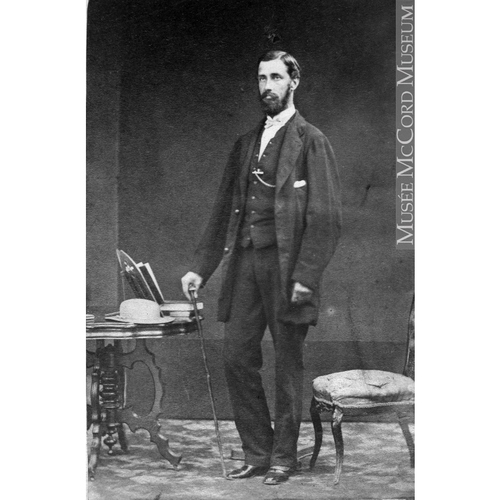
Source: Link
AMBROSE, ROBERT STEELE, farmer, organist, choirmaster, teacher, and composer; b. 7 March 1824 in Chelmsford, England, son of Charles Ambrose, an organist, teacher, and composer, and Sophia Stoneham; m. 28 July 1863 Elizabeth (Lily) Boyle, and they had five sons, including the noted musician Paul Ambrose*, and two daughters; d. 31 March 1908 in Hamilton, Ont.
Robert Ambrose grew up in Chelmsford and attended the parish church of St Mary the Virgin, where his father was organist. He received his early musical training from his father and probably sang in St Mary’s choir. With his parents, five brothers, and one sister, he emigrated to Upper Canada in 1837. Charles Ambrose purchased Farm Hill, near Guelph, with the intention of becoming a farmer but, lacking the necessary training and experience, he found the task too much of a challenge. He moved to Hamilton in 1845 to become organist of Christ’s Church, leaving Robert alone to run Farm Hill. The same year Robert became organist at St George’s Church in Guelph and began giving piano lessons to several local pupils. In letters to his father, he made it clear that he did not like farming and complained that the ploughing was damaging his hands and interfering with his musical activities.
Robert left the farm in October 1847 and moved to Kingston to join his brother Charles in teaching music. Charles left Kingston the following March, and Robert took over his students. To make a living as a music teacher and church organist was a struggle in mid-19th-century Canada. Robert’s father, who continually worried about having enough money to support his family, wrote from Hamilton early in 1851 advising his son: “You had better dig your own grave than marry a woman without money and still teach music.” However, Robert much preferred music to farming and continued to expand his teaching in Kingston. He appears to have served the musical needs of the community in other ways as well: the city directory for 1857–58 lists him as a “pianoforte tuner” and as organist of St George’s Church. In March 1862 he led the choral service at the consecration of John Travers Lewis as first Anglican bishop of the diocese.
In 1863 Ambrose moved to Hamilton to become organist and choir director of the Church of the Ascension, a position he would hold for 20 years. A year later he was appointed musical director of the Wesleyan Female College (later known as the Wesleyan Ladies College and then the Hamilton Ladies College). During the 25 years he was at the college, hundreds of students sang in his choirs and studied privately with him.
Ambrose was also a prolific composer. He is credited with more than 100 musical works, including approximately 80 songs, 14 part-songs, various anthems, and 25 instrumental works. He achieved North American prominence with “One sweetly solemn thought,” a setting of Phoebe Cary’s poem “Nearer home.” Published in 1876 by Samuel and Albert Nordheimer, it was one of the most popular songs written by a Canadian in the 19th century. It would be recorded in various arrangements for voice, harp, organ, trombone, and piano by artists in Canada and abroad, including singers Ernestine Schumann-Heink, Alma Gluck, and Louise Homer. Among his other published works are the songs “Under the snow (not lost but gone before)” (1878) with lyrics by Alexander Hamilton Wingfield* and “Abide with me” (1882), and the choral piece “May God preserve thee, Canada” (1886). Ambrose’s ability to write attractive musical settings of texts with uncomplicated accompaniments accounts for the popularity of his compositions. In recognition of his contribution to musical life, in 1891 he was elected president of the Canadian Society of Musicians.
Two of Robert Steele Ambrose’s songs, “One sweetly solemn thought” and “Under the snow,” are reproduced in The Canadian musical heritage, ed. Elaine Keillor et al. (11v. in 14 to date, Ottawa, 1983– ), vol.3: Songs I to English texts, ed. F. A. Hall (1985): 110–12 and 175–77, respectively.
HPL, Arch. files, Ambrose coll.; Wesleyan Ladies College; Scrapbooks, Victorian Hamilton. Daily Times (Hamilton, Ont.), 1 April 1908. Globe and Mail, 2 June 1941: 27. Hamilton Herald, 1 April 1908. Hamilton Spectator, 17 June 1879, 22 June 1887, 24 Aug. 1889. E. S. Ambrose, Of seven .sons, 1837–1923 (typescript, Hamilton, 1942; photocopy at HPL). The consecration of the Right Reverend John Travers Lewis, LL.D., first lord bishop of the diocese of Ontario (Kingston, 1862; copy at ACC, Diocese of Ontario, Kingston). DHB. Directory, Kingston, 1857–58. Encyclopedia of music in Canada (Kallmann et al.). Mary Harrington Farmer, The Church of the Ascension, Hamilton: a short history, 1850–1950 (Hamilton, 1950). Helmut Kallmann, A history of music in Canada, 1534–1914 (Toronto and London, 1960). T. J. McGee, The music of Canada (New York and London, 1985). E. B. Moogk, Roll back the years: history of Canadian recorded sound and its legacy, genesis to 1930 (Ottawa, 1975).
Cite This Article
Frederick A. Hall, “AMBROSE, ROBERT STEELE,” in Dictionary of Canadian Biography, vol. 13, University of Toronto/Université Laval, 2003–, accessed December 17, 2025, https://www.biographi.ca/en/bio/ambrose_robert_steele_13E.html.
The citation above shows the format for footnotes and endnotes according to the Chicago manual of style (16th edition). Information to be used in other citation formats:
| Permalink: | https://www.biographi.ca/en/bio/ambrose_robert_steele_13E.html |
| Author of Article: | Frederick A. Hall |
| Title of Article: | AMBROSE, ROBERT STEELE |
| Publication Name: | Dictionary of Canadian Biography, vol. 13 |
| Publisher: | University of Toronto/Université Laval |
| Year of publication: | 1994 |
| Year of revision: | 1994 |
| Access Date: | December 17, 2025 |





